Asus TUF Gaming RTX 3080 OC Review - hesslockonamind
Today we're reviewing the Asus TUF Gaming RTX 3080 OC, the first third-party GeForce RTX 3080 graphics card to come our way and we'rhenium same interested to see how information technology compares to Nvidia's Founders Edition model. We'll be checking out gambling performance which should be very similar to the FE card, only likewise thermal and overclocking results.
Basic, let's tear the TUF Play RTX 3080 OC down and postulate a look at the cooler and PCB. Please short letter this was through with later we collected all our thermal and performance data. Starting with LED lighting, because of course, that's important. The TUF is artistic movement which we like, there is a diminutive abstemious bar above the 'TUF' branding along with a backlit logotype which faces outwards when the card is traditionally mounted.
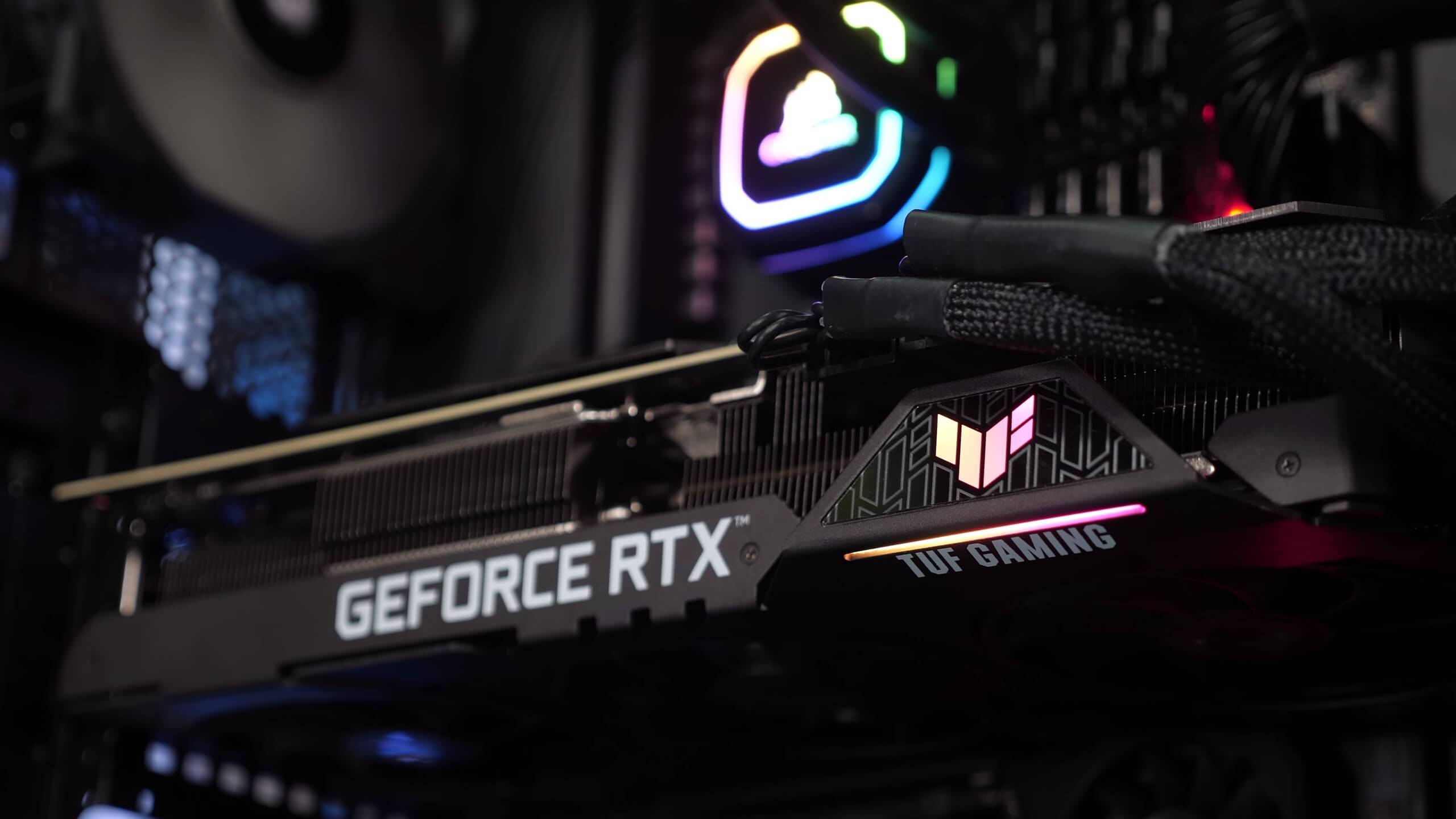
In footing of design and appearance, the TUF Gaming looks like your typical full-end graphics visiting card. It's a 2.7-slot design, so it takes functioning 3 slots, information technology measures 30cm long, stands 12.7cm tall and weighs in at 1385 grams, so it's somewhat heavier than the 1355 Hans C. J. Gram Founders Version model. It's mostly covert, so IT testament suit most builds and Asus has enclosed a couple of 'TUF' theme design elements like the tire tracks on the backplate, for instance.
We likable how there's no plastic along the card, apart from the fans course. The fan shroud has been constructed from aluminum, giving it a premium look. Asus are also using the axial-technical school fans and since there are three in total, they've reversed the rotation of the heart and soul fan to boil down turbulence, the fans each mensuration 90mm in diameter. We should besides note that the card includes a stop-lover feature which activates when the GPU drops below 55C.
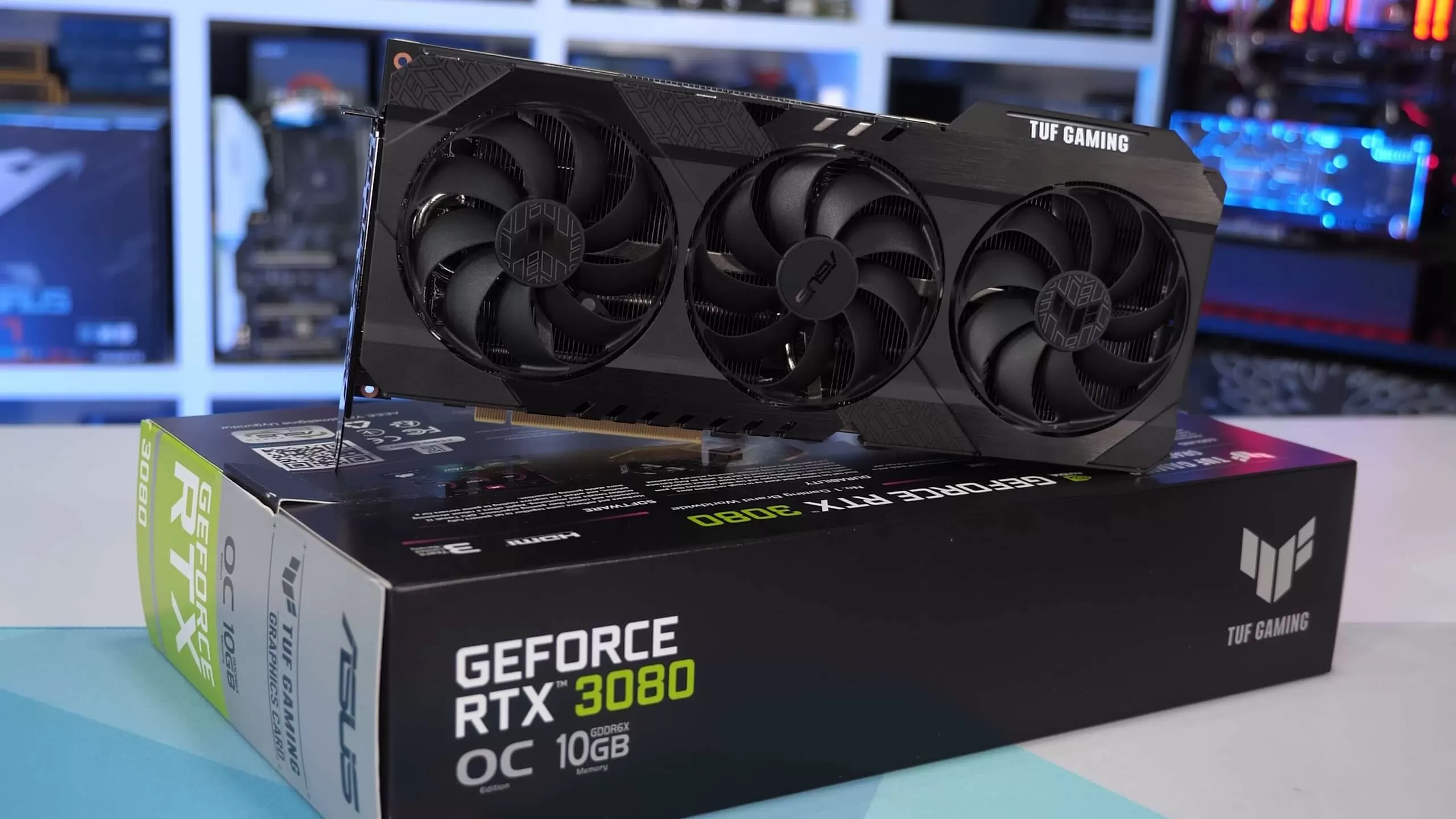
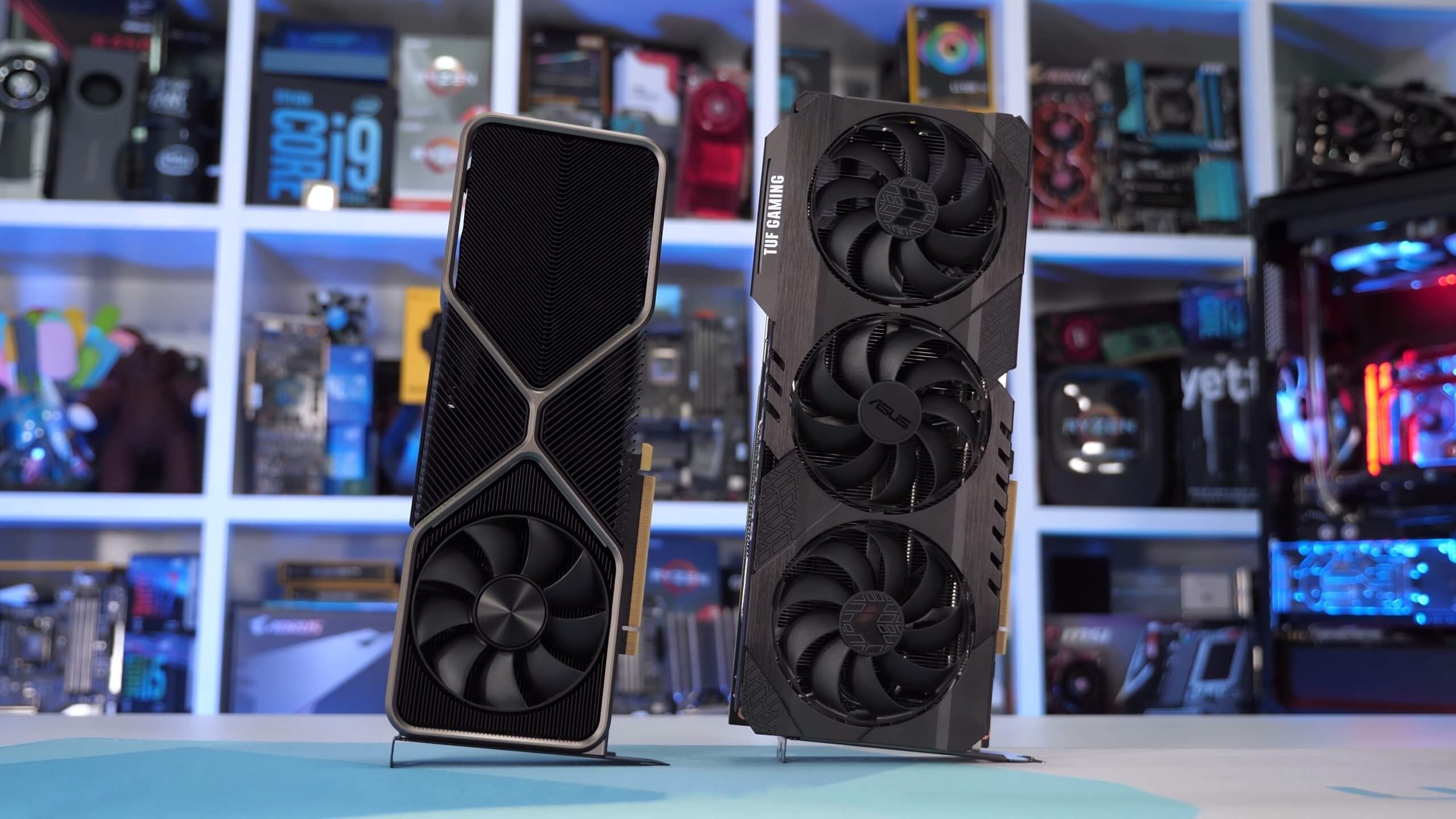
Around at the I/O close of the card we find two HDMI 2.1 ports and 3 DisplayPort 1.4a outputs. That's an additive HDMI outturn when compared to Nvidia's FE version, though note it can still only support capable 4 simultaneous displays. Asus as wel points out that this model features a very heavy-armed unsullied steel I/O bracket which they say protects against rust-brown while providing a more long and secure saddle horse. Can't say we've ever had an issue with the modular brand brackets, but if you undergo, well this will exist a welcomed feature article.

Pulling this affair apart to take a break wait, starting with the heatsink and fans, we give birth a very serious looking for heatsink here, in point of fact information technology looks like something you'd ask to find on an ROG Strix model and not a card with TUF branding, and it really is very large, weighing in at 820 grams.
There are two monolithic banks of fins which are affiliated using fractional a dozen 6mm gelatinlike nickel plated copper heatpipes, and all connect to a sizable nickel plated copper base plate.
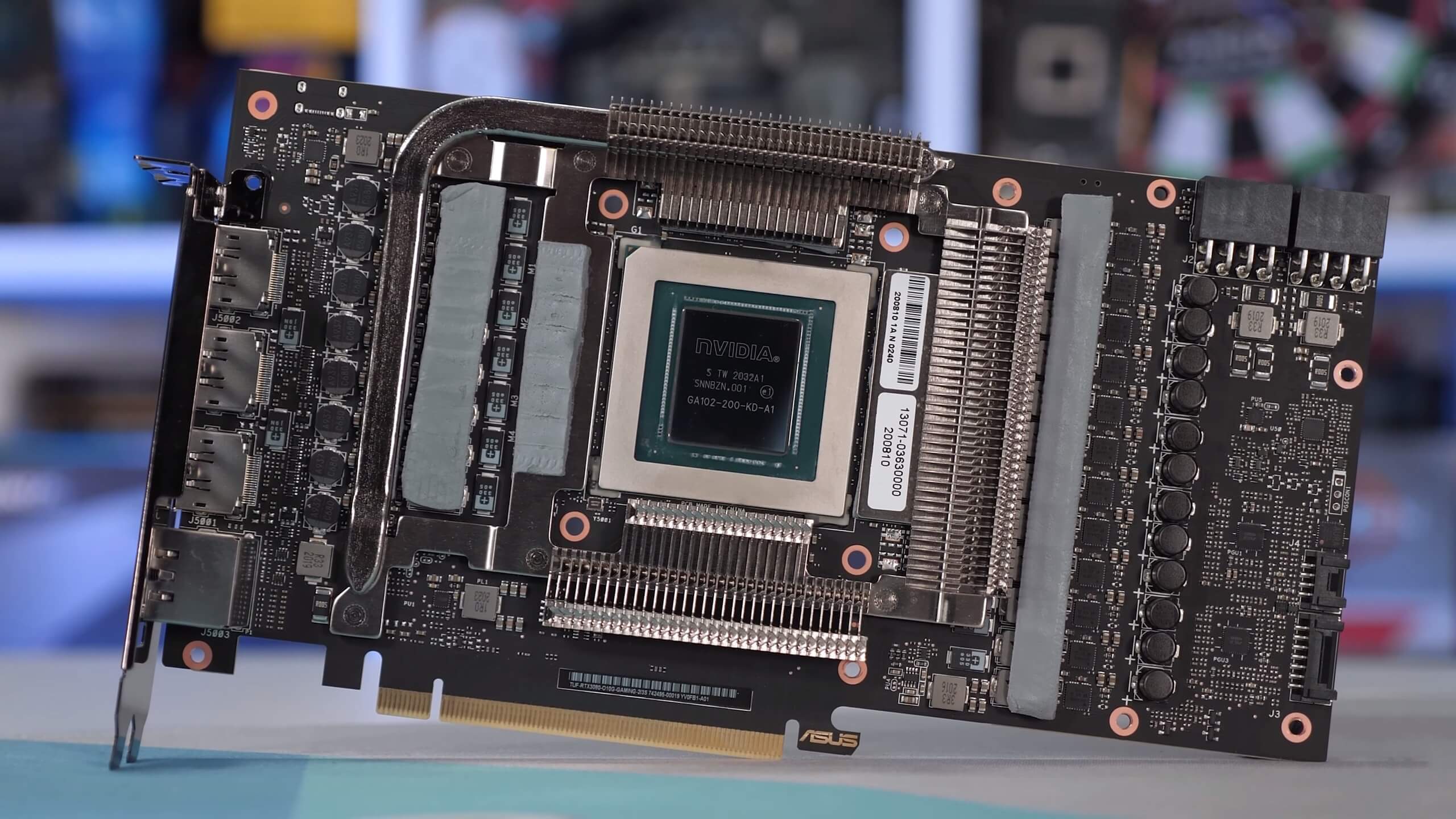
Using an aluminum plate, it directly cools the VRM, soh that's solid to see, but there's a whole lot Thomas More to this excogitation as there is a irregular heatsink which direct cools the GDDR6X memory arsenic well as the power delivery for the memory components. It's an sensational moment of kit that fits in snug beneath the main heatsink. Asus give also ill-used a few high quality thermal pads to aid in heat transfer from this smaller heatsink to the primary heatsink. Oh and for those of you inquisitive the smaller heatsink weighs in at 70 grams.


On the back position of the card we find a rather thick atomic number 13 back plate which weighs 138 grams and has been wont to strengthen the lineup and reduce PCB sag, or in this case completely eliminate it. We think this is actually the thickest backplate we've ever seen on a graphics board. Asus has also employed a series of thermal pads to remove built up heat energy from the rear side of the PCB tooshie the VRM and GDDR6X memory chips. There's also a few cut outs to aid in air-flow.
Now over to the PCB, we find a 24cm long by 10.6cm tallish PCB, thusly a fairly compact board, though it is crammed full of components. Close the massive GA102 die are the GDDR6X memory chips and then flanking them happening either side are boatloads of inductors and power stages. In total the card packs 20 power stages, and present we're looking an 8 + 6 + 4 ability phase design victimization SIC641ACD 55A powerstages, though please note two of the 8-phases drive cardinal power stages, so a trifle of an odd contour, but this is what Asus has bygone with.


If you'Ra wondering what the 8 and 6-stage portions top executive, the suffice is the GPU. So 14 phases feed into the GPU, surgery 16 55A powerstages. The 8-phase power rail is for NVVDD and the 6-phase power rail is for MSVDD while the 4-form power rail is for the GDDR6X memory.
For comparison, the Nvidia reference board uses an 8 + 5 + 3 power phase design featuring 50A Alpha & Omega Semiconductor power stages. In unusual speech, Asus has beefed up the TUF Gambling asymptomatic over the Nvidia consultation spec.
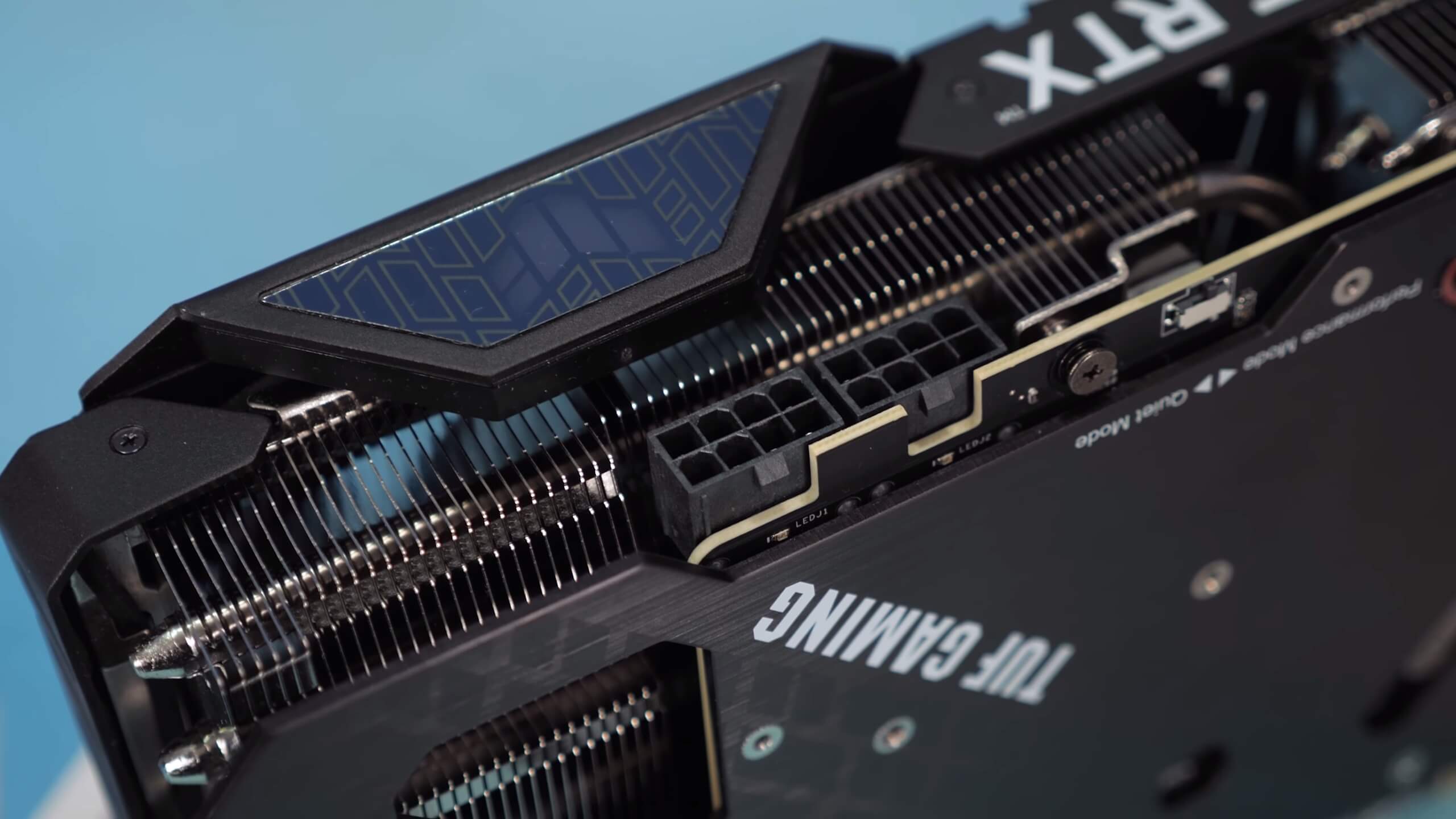
There's also two 8-pin PCIe baron connectors eating index into the graphics card and you'll besides find a twofold BIOS trade that allows you to vary from the default 'execution' BIOS to a 'quiet' BIOS. Both modes run the card at 340 watts, sol we're just looking at a change to the fan visibility which will see the card run hotter in the unruffled style.
In damage of clock specifications, Asus lists a core time oftenness of 1815 MHz which is a 5% boost over the 1730 MHz default spec. The GDDR6X retentivity though has been left-of-center at 19 Gbps, so we're just looking at at a true temperate GPU overclock here. Each that aforesaid, let's locomote on to see what clock quicken this model maintains when underload.
For these GeForce 30 serial publication artwork tease reviews we'll be using Shadow of the Tomb Raider for completely accent testing and will be reporting temperatures after 30 transactions of gameplay. This saw the TUF Gaming tip at hardly 63 degrees in a 21 degree elbow room inside the Corsair Obsidian 500D, fully populated with fans. That's a heavy 15 degree drop in temperature when compared to Nvidia's Founders Version model.


To maintain this temperature the fans spin at adequate to 1900 RPM and while that's a reasonably high fan speed, the card was amazingly hush, generating just 42 dBA of noise, devising IT slightly quieter than the Atomic number 26 version. The typical core clock speed seen during our testing was 1935 MHz and under the same conditions that's a 5% increase over the Founders Version model. This saw power consumption step-up away 7% from 323 Watts with the FE model to 344 Watts with the TUF Gaming.
Overclocking
Now for overclocking, with the limits reached we again saw a peak operating temperature of 63 degrees simply this time the fans spun up to 2000 Rev. The card wasn't terribly loud at this fan hotfoot. The overclock saw the cores operate at 2 GHz and the memory also hit 20.6 Gbps, an grand transfer travel rapidly. Finally, when overclocked the menu sucked down 357 watts, a small 4% increase from the manufacturing plant OC configuration.
Let's move into the bench mark graphs to see what overclocking gets America. We're testing with our Ryzen 9 3950X GPU test rig with 32GB of DDR4-3200 CL14 retention. The latest drivers available at the time of testing have been used, and for this one we birth just a few select games to look at.
Benchmarks
Starting with Death Stranding numbers at 1440p, the TUF Gaming was a single framing faster than Nvidia's FE model, striking 158 Federal Protective Service. That's a pretty disappointing increase and we weren't able to make much advisable with a manual overclock, boosting performance away a farther 2%.

The results at 4K were just as underwhelming, here the TUF Gambling was 2% faster than the FE mannequin and our overclock netted us an extra 2% performance.

The gains seen in Rainbow Six Military blockade were a little more impressive, Hera the TUF Gaming was 6% quicker than Nvidia's FE model, hitting 346 FPS. That's a emblematic manufacturing plant overclock, but unfortunately through with boost manual tuning we were only capable to extract 2 extra frames, well under a divorced percent gained Hera.
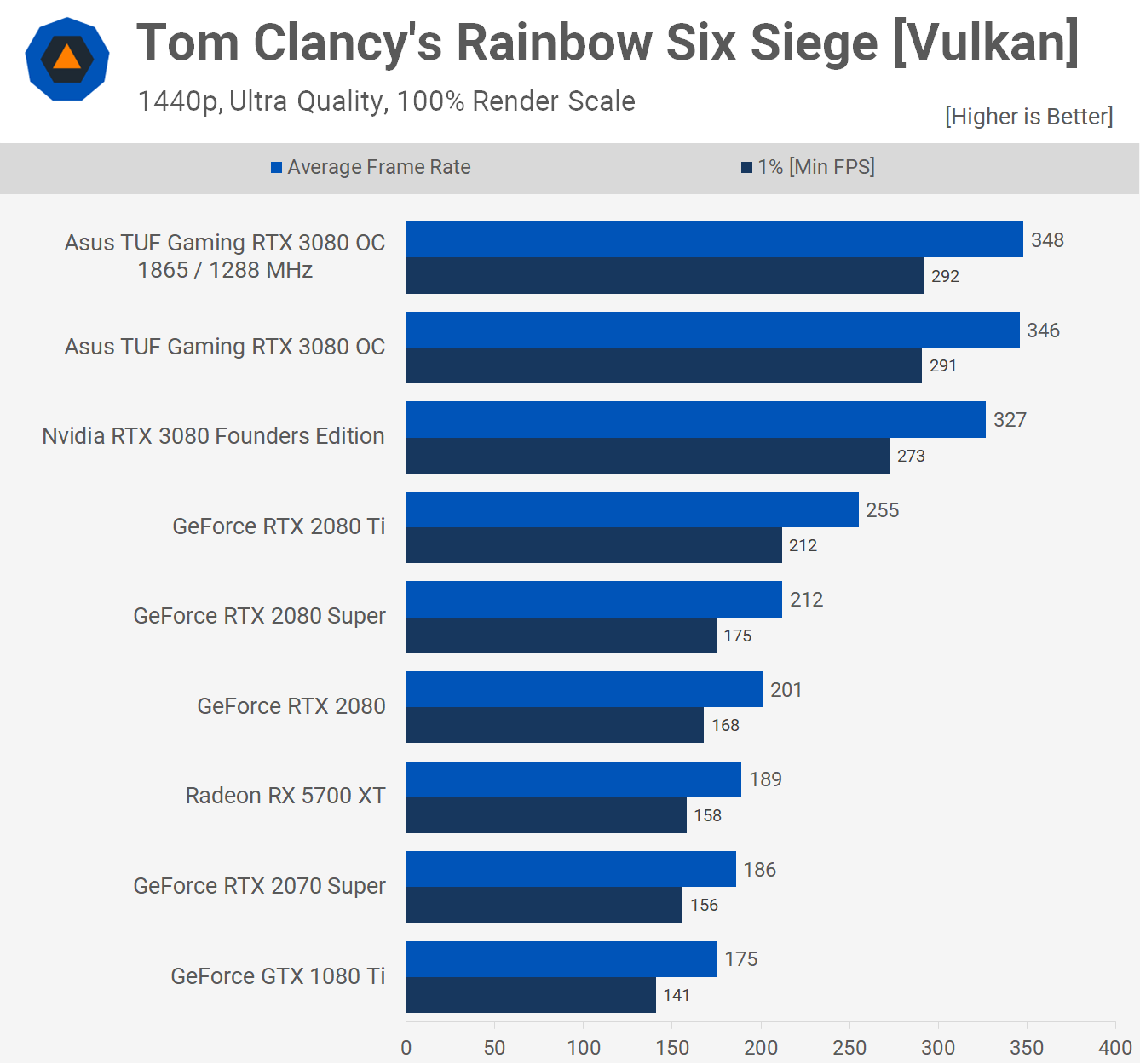

The 4K data looks much the same, again the TUF Gambling was 6% faster than Nvidia's Founders Edition model and our blue-collar overclock was unserviceable.
Shadow of the Tomb Raider saw a 4% increment for the TUF Play concluded the FE model at 1440p, though rather interestingly this clock our hand-operated overclock netted US a further 3% increase in performance.
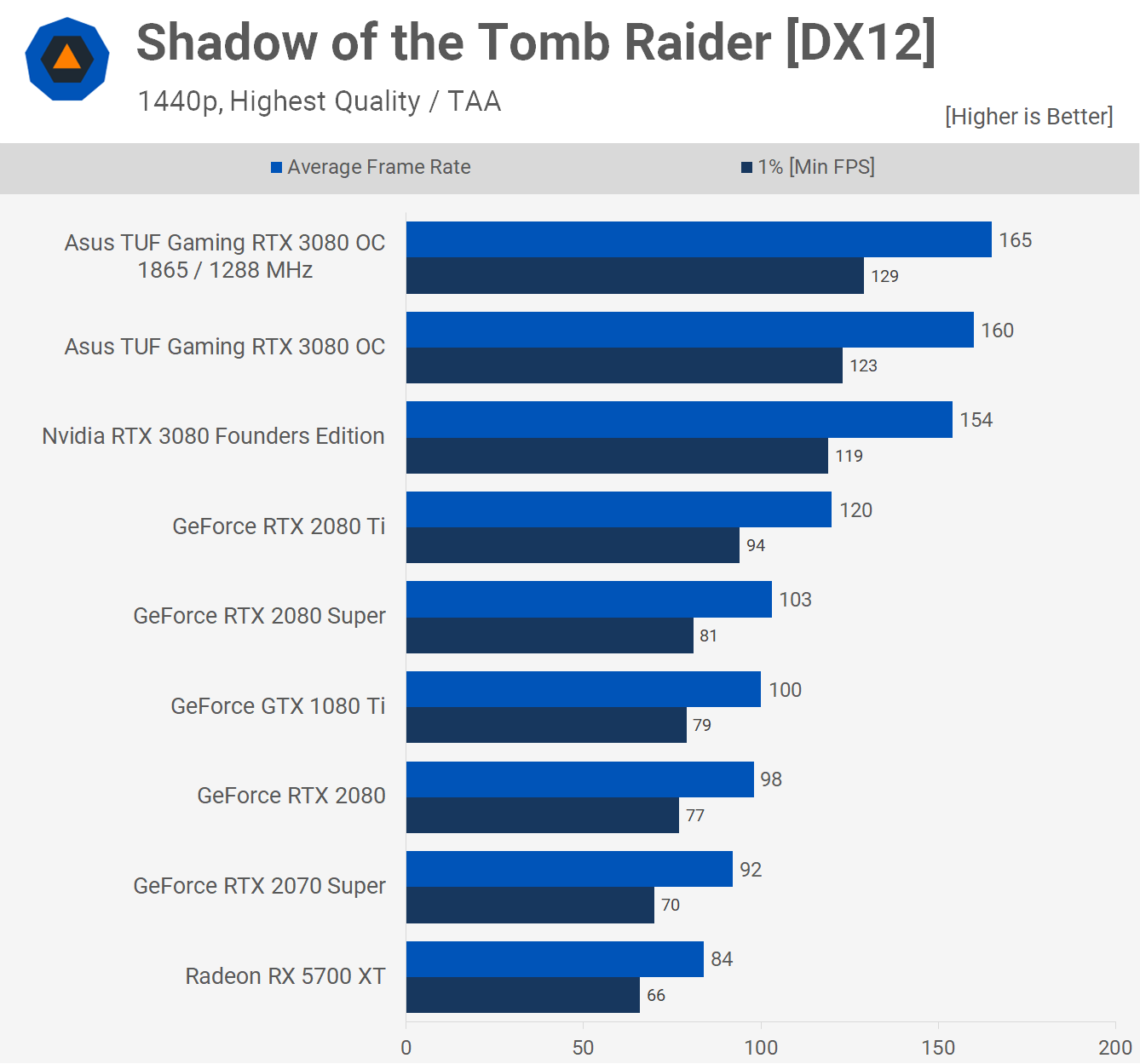

Analogous margins were seen at 4K, Hera the TUF Gaming was 5% faster out of the box and then 8% faster with our overclock, though that was just a 3% increase over the Asus factory overclock.
Temperatures
Present's a more in-depth look at the stock temperatures afterward running Shadow of the Tomb Raider for 30 minutes in a 21C room. The PCB temperatures were taped using K-character thermocouples. For the GPU rear PCB temp the probe is attached to the backside of the PCB behind the GPU and we were expecting temperatures to live higher, so IT would seem the heatsink connected the frontside does a good job of extracting heat from the GPU. The GPU die temperature is the result you've already seen, we're exactly reportage the internal sensor hither.

Then the GDDR6X temperature has been reported victimization a thermal probe, attached to the PCB 'tween the memory chips, and then that it doesn't intervene with the thermal pad and it's contact with the memory chip. The same method was accustomed bill VRM temperatures, 4 probes were used to detect the VRM hot spot and Hera we'Re looking at a peak of 66C which is very good. Overall, the TUF Play runs amazingly chill.
What's to Equal
Asus has through an excellent job with the TUF Gambling RTX 3080 OC, information technology's a heavy quality graphics card and better than Nvidia's own Founders Variation in every measurable way. IT's quieter, significantly cooler, faster out of the loge and foremost of all, it doesn't require a silly 12-pin magnate adapter or specialized cable.
The only area where the Founders Edition model might follow better is the physical appearance, but that's entirely subjective. While we do like the look of Nvidia's version, the TUF Gaming still looks great and we appreciate the use of high quality materials all just about.

The fact that the TUF Gambling can represent up to 6% faster while running 15C cooler seals the deal for us. There's just no way we'd buy the Founders Edition over this Asus model for the aforesaid price.
At this target we'ray allay in the outgrowth of checking unfashionable other AIB RTX 3080 cards, thus there might be better options, but we can't imagine they're going to make up that much better. We've seen numerous 5700 XT artwork cards that run hotter than the TUF Play RTX 3080 OC, so there's zero denying Asus has done an excellent caper. Should the cost follow right, then we see none reason non to buy this art card.
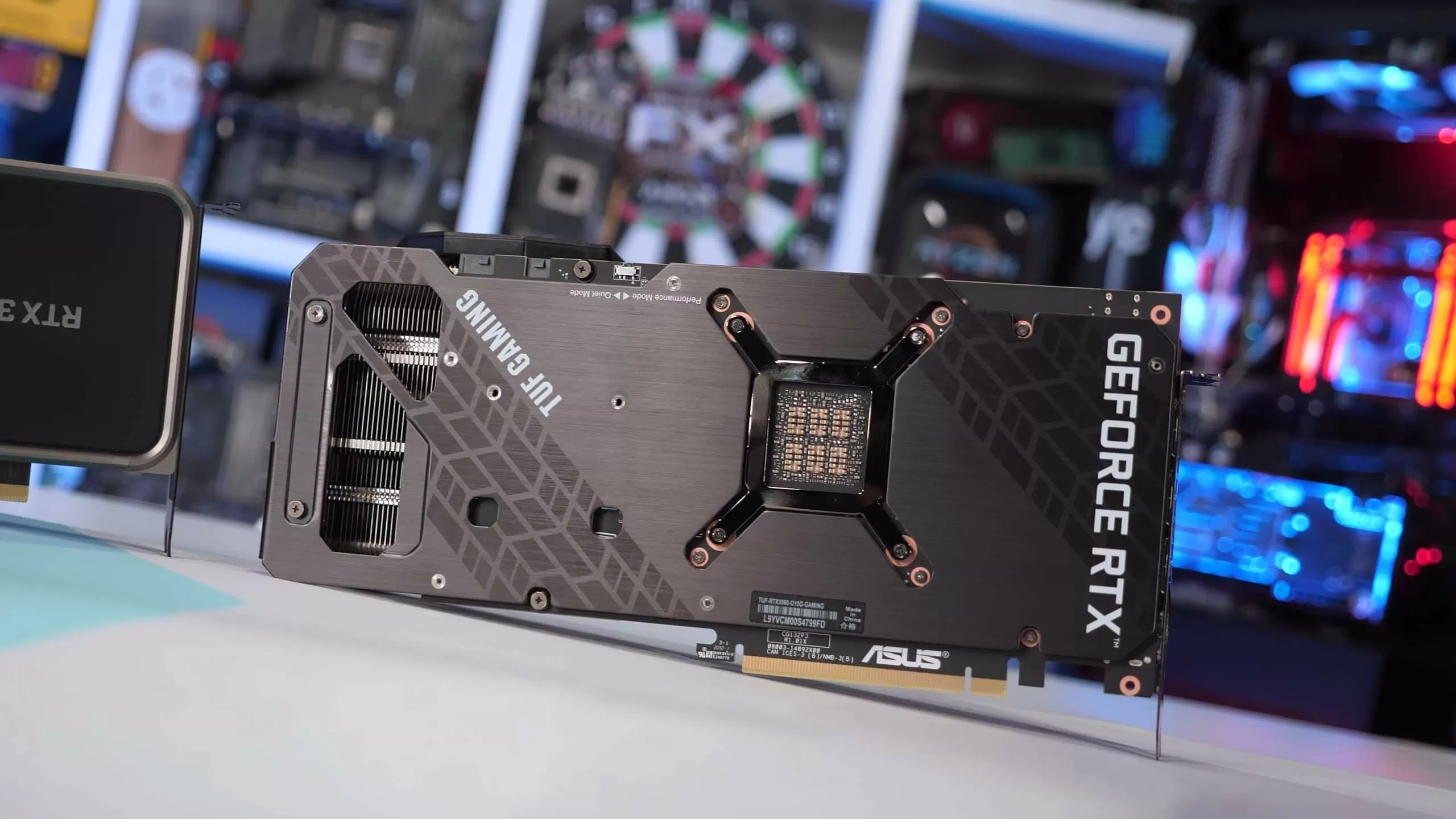
The Asus TUF Gaming RTX 3080 OC is currently listed for $700, which matches the MSRP for standard RTX 3080 boards. That said, it's also unavailable everywhere we looked, but if you can one of these days snag one for $700, then you've through with OK.
We were surprised to find how much better this affair is than Nvidia's intricate Founders Edition, and we like to think that our scrutiny with previous TUF Gaming cards helped motivate Asus to put together this excellent design and attention to detail.
Shopping Shortcuts:
- Nvidia GeForce RTX 3080 along Amazon
- AMD Radeon RX 5700 along Amazon
- AMD Ryzen 9 3900X on Amazon
- AMD Ryzen 5 3600 on Virago
Source: https://www.techspot.com/review/2102-asus-tuf-geforce-rtx-3080/
Posted by: hesslockonamind.blogspot.com


0 Response to "Asus TUF Gaming RTX 3080 OC Review - hesslockonamind"
Post a Comment